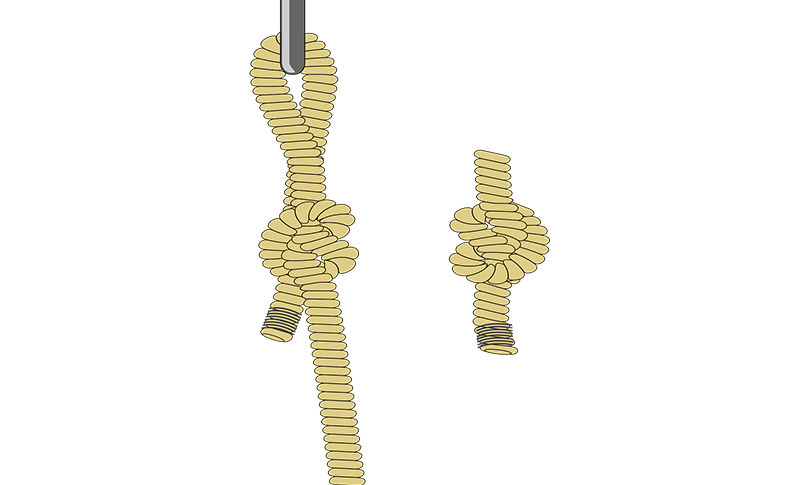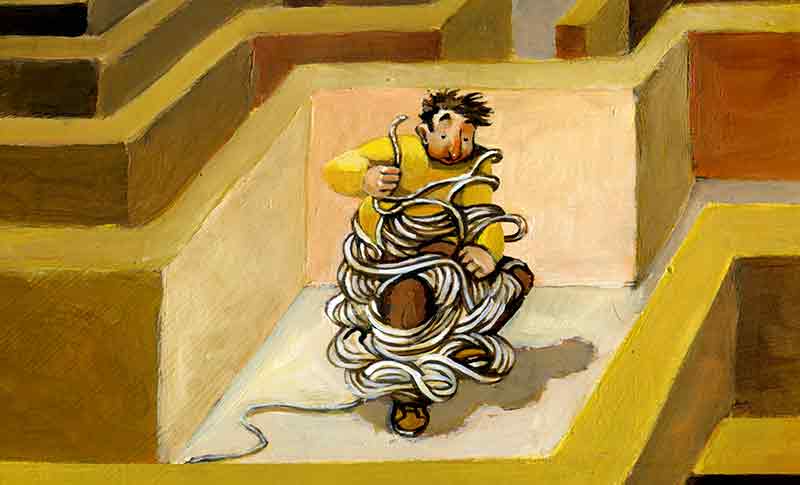During the centuries when tall ships adorned with sails dominated the seas, any skilled sailor knew how to tie dozens of knots with intriguing names such as the anchor bend, the bowline and the half-hitch.
The knots we get in our muscles aren’t nearly so exotic or desirable; they’re painful. In addition, they’re not actually knots. So, what are they?
The Knot That’s Not
We have approximately 3-400 pairs of muscles in our bodies; as one muscle pulls in a certain direction, the other pulls in the opposite direction. Given all the work done by these muscle pairs, it shouldn’t be surprising to learn that when we work muscles hard, we may create an imbalance within the pairings. There isn’t enough distance between the muscle fibres, so the muscles can no longer glide freely and get stuck together.
This tight, painful spot that we call a muscle knot can be referred to as an adhesion – fibres sticking to each other – or a myofascial trigger point (MTP). Trigger points may only hurt when you put pressure on them or they can regularly send pain signals along your neural pathway.
Tying Those Knots or How do Knots Form?

There are three common causes for muscle knots:
- Accidents: Acute trauma to your body, such as a fall or a sports injury can strain your muscles and joints.
- Postural stress: Regularly carrying heavy objects (e.g., purses) on one shoulder, sitting too long with poor posture, sitting without support – bleachers, anyone? – or lifting heavy objects improperly.
- Overstimulation: Strenuous sporting pursuits or exercise; lifting weights.
Preventing Muscle Knots
Now that you understand a bit about the causes and the mechanics of muscle knots, you’d undoubtedly prefer to avoid them! There are steps you can take to prevent a muscle knot from developing:
- Hydration and Diet: Drink plenty of water and maintain a healthy diet. Water helps to lubricate your muscles, while caffeinated drinks, alcohol and fast foods loaded with salt help dehydrate you. Ensure that you get enough of foods that contain B vitamins, potassium and calcium, such as bananas and yogurt. If you are mindful of what you put into your body and eat and drink healthily, you are less likely to get injured.
- Lifestyle: Lack of sleep and ongoing stress makes you more vulnerable to injury. Get proper rest and don’t abuse your body. Even a short period of daily meditation or yoga can be useful for relaxation.
- Massage: It’s not just for spa days – think of professional athletes. Massage therapy is a useful tool for keeping muscles oxygenated, flexible and healthy.
- Regular Breaks: Many of us today spend our lives seated at a desk and tied to our computers. Our bodies are designed to move, and it’s unhealthy for them to remain in one position for too long. At work or at home, get up each hour and walk around a bit – fill up your water bottle, for example. While sitting at your desk, stretch your neck, uncross your legs and straighten your shoulders. Movement is good.
- Exercise Regularly: As noted above, our bodies are designed for motion. Build regular exercise into your weekly schedule so that you remain flexible and strong. A physiotherapist can assist you in determining which exercises are best for your lifestyle and physical strengths and abilities.
- Stretch: When you finish exercising and your muscles are warm, do a series of stretches to help them remain flexible.
How to Get Rid of a Muscle Knot

As much as we’d all love to avoid muscle knots altogether, they may occur. When you feel a knot and experience pain, your body is sending a signal that it needs help. Consider these possibilities to get rid of a muscle knot:
- Rest: It’s time to take a break from whatever is causing the pain, whether it’s sitting at your computer or lifting weights at the gym. Give your body some time to heal.
- Massage: While it’s great for prevention, massage therapy is also very useful as a treatment for knots. A registered massage therapist can break up your adhesions, relieve muscle pain and suggest appropriate self-care that may include foam rollers or other tools.
- Physiotherapy: If you have been bothered by pain for a while, a physiotherapist will help identify the underlying causes and will provide relief with the most appropriate techniques.
- Stretch: Gentle range-of-motion activities are usually helpful, but it is best to discuss your proposed routine with a physiotherapist, massage therapist or athletic trainer before embarking on it. Be sure that your movements are pain free.
Muscle knots are NOT insurmountable. With the proper attention, you should be able to resume your usual activities and prevent them from recurring regularly.
